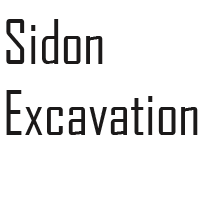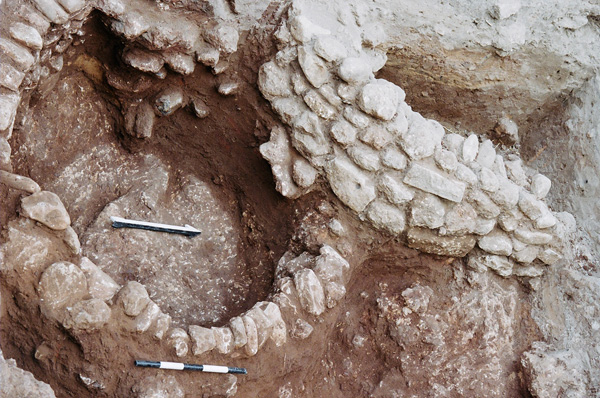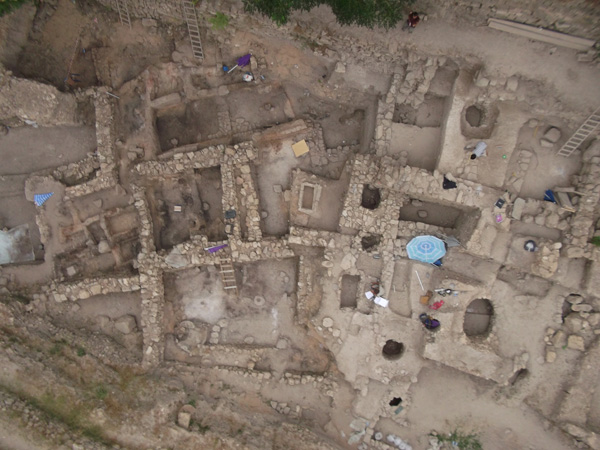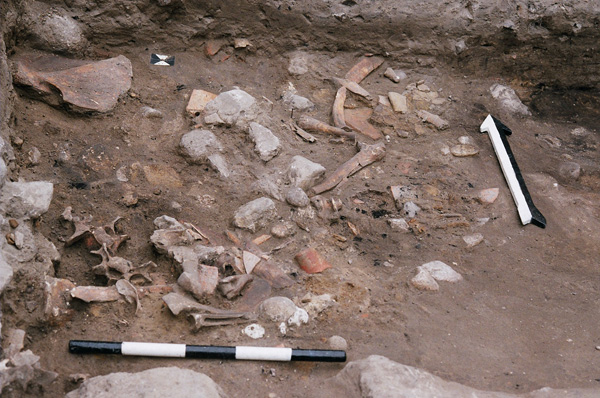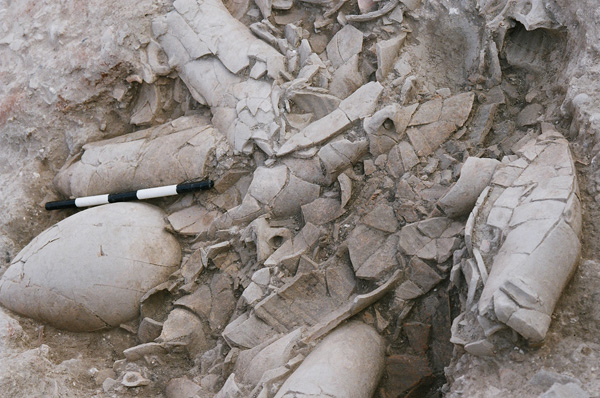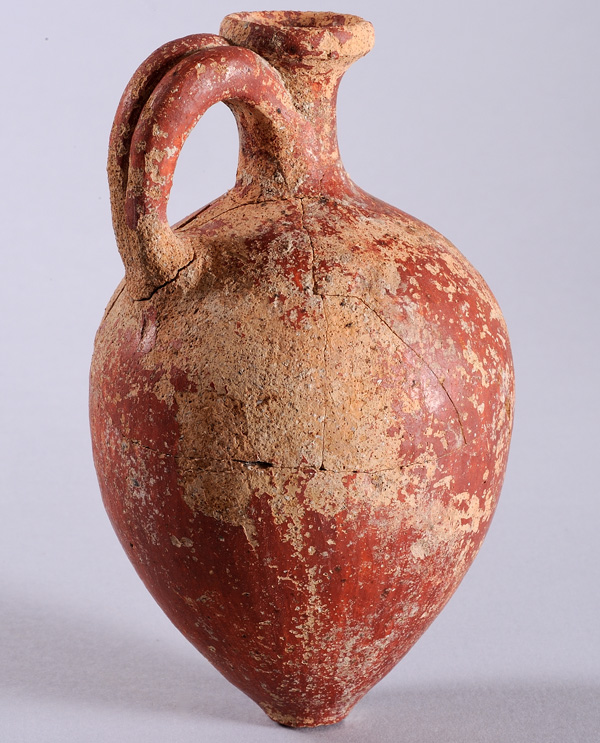YEAR 2012
The fourteenth season of excavation on the mound of the ancient city of Sidon carried out by the British Museum in collaboration with the Department of Antiquities of Lebanon took place this season on College and Sandikli, two urban sites in the heart of the city. College site in particular has already proven to be an exceptional location of valuable new information on the past largely due to the continuous occupation of the area from the third millennium BC to the Iron Age as testified by the 1998-2011 excavations.
In recent months, a great deal of activity has taken place in the northern section of the site as construction of a future Sidon museum is due to begin there in September. Although most of the foundation pillars for the museum will be placed on either side of College site in order to avoid damaging extant archaeological relics, nevertheless one pillar will have to be placed on the site of one excavated room, part of the Early Bronze Age building. With this time limit in mind, various teams have raced to finish work in this particular room where, indeed, they reached bedrock. Astonishingly, the prospecting revealed a curving wall and a pit, almost certainly part of a round house and the first structure of occupation found at bedrock on College site dated to the end of the 4th millennium BC. This revelation inevitably changes the premise that Dakerman, which is located on the sea and one kilometre south of College site, is the locus of Sidon’s earliest proof of occupation.
New and interesting Early Third Millennium levels (EBII) were revealed with a concentration of burnt wheat and barley and with a great deal of animal bones including aurochs, bear and deer which may well be the remains of a feast as all the parts recovered were meat-rich segments belonging to young individual beasts. In one area, the curious discovery of three mandibles including one belonging to a 9 to 12-year-old child together with the right mandibles of a bear and a deer has posed an interesting puzzle. Why were right mandibles deliberately chosen and what was a human mandible doing in this context? The presence of human skulls found with those of aurochs is known in Turkey and in Ugarit a lion mandible was found in the palace quarter. Mandibles are certainly a common find in ancient deposits and moreover are considered symbolic or trophy-like. However the presence of a human mandible in such a context is a new phenomenon.
In the grave area of the site, exploration was extended to the Middle Bronze Age and more graves were uncovered this year bringing the running total so far to 123 burials. Further information was revealed on feasting activities that took place during funerals. An area with stake holes was found in the same way as those discovered 4 years ago. The proximity of the cuts suggests they were probably not all cut at the same time but rather over a period of time indicating these were only temporary structures to hold thin stakes perhaps to protect the occupants from the wind or sun. Every time a burial was to be interred a small shelter was put up and food such as lentils, chick peas and beans was consumed as evidenced by the remains which were found burnt in tannours. One of the burials revealed a unique cylinder seal, Mesopotamian in style with Syrian influence and a scarab of Egyptian influence, thus once again designating Sidon as an intermediary site on the crossroads of major ancient civilizations and cultures. The cylinder portrays the God of water with a stream of water flowing from his elbow together with the interceding Goddess Lama who accompanies a worshipper advancing towards a seated Goddess.
The monumental temple in which a breakage ceremony took place during the Hyksos period was further excavated and a new room uncovered. It revealed a large platform in the middle of the room together with pits and post holes. A small basin was sitting on a thick layer of white plaster.
The Iron Age which is concentrated between the southern section of College site and Sandikli has revealed stunning architecture typical of the Phoenicians and rarely found in Lebanon to date. This includes ashlar masonry consisting of big blocks of stones used in the construction of walls and floors or placed strategically at an angle in order to create a void and then filled with a conglomerate of stones. Both techniques were uncovered in Sidon, propitiously, side by side. At least two new buildings dating to the 7th and 8th century BC were uncovered this year. They will be further excavated in the next season. More than 50 amphorae were found in the vicinity of one of the ashlar constructions either stacked in pits or crushed on the floor together, in some instances, with a quantity of fish scales.
A Phoenician plate was also found on college site bearing a unique incised inscription of 10 Phoenician letters. The inscription is a unique piece of Phoenician writing and, in spite of an almost complete absence along the Lebanese coast of Phoenician texts from the early Iron Age; it can be dated according to the palaeography, to the first half of the eighth century BC.
The first word of the inscription, known as the singular absolute MZBH, usually means “altar.” Here MZBH T could be a plural in the construct i.e. “Altars of …” In this case, it is not incised on an altar but on a plate, itself the support for sacrificial offerings presented by the person whose name immediately follows MZBH T designated to mean “servant” (= BD) of a deity. The inscription will be subject to further in-depth study.
This year’s excavation also revealed a stunning small Attic vase. It portrays two horsemen riding off to war wearing white tunics and holding spears and the god Hermes with a worshipper standing in front of him raising both hands.
A coin depicting the well-known legend of Europa riding the bull was also found in Sidon this year.. In view of the high calibre of Cretan imports found in Sidon over the years, there have been suggestions, that perhaps Europa might actually have been a Sidonian.
Conclusion
The excavation in Sidon unfailingly continues to disclose exceptional continuity and feedback in the practices of ancient cult and ritual. After revealing a continuous sequence of occupation from the Chalcolithic to the end of the Early Bronze age III and further stratigraphic continuity in the Middle Bronze Age with elements of the Late Bronze Age, both College and Sandikli sites propound a significant new chapter for the years to come. This will include revealing the stratigraphy of the Iron and Late Bronze age which was only found sporadically until now. At least 3 levels belonging to the Persian Period and 3 others with associated buildings have been recently found and only touched upon.
The continuity of work in Sidon is far from repetitive. Every year has helped to refine the information and data already discovered. New questions are now being posed for the Late Bronze and Iron Ages. This will complement the incredible stratigraphic sequence already uncovered for the earlier periods making Sidon one of the most important archaeological projects in the Levant.
Figures
1 College site.
2 Curving wall probably part of a round house and pit. Bedrock, end of the 4th millennium BC.
3 Bones belonging to a young auroch. EB IIB.
4 Jug burial 115/121. MB IIB.
5 Amphorae dating to the Persian period all contained in a large pit.
